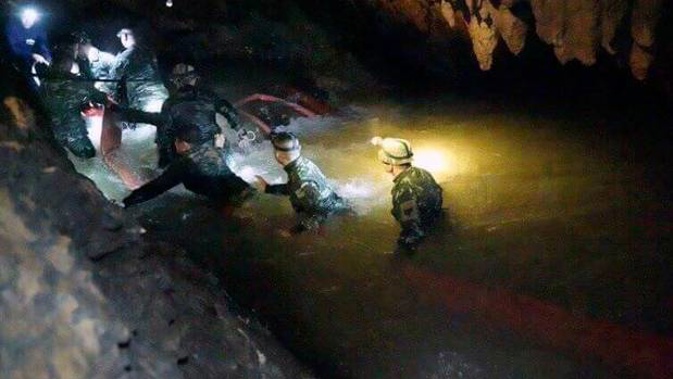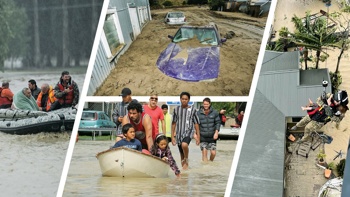"We will take care of them like they are our own children," he said. The group are being taught how to use diving masks and breathing apparatus, he added, but from the safety of the muddy bank which for now remains their sanctuary.
Getting out of the cave won't be easy. It will require diving of about a kilometre which could not be completed all at once. In total, it was expected to take three hours.
Another British expert, Gary Mitchell, described the challenging conditions. "There's air pockets along the way," he told the Associated Press.
"It's confined spaces. It's almost zero visibility. There's currents to battle against in places as well. So it's a really quite a strenuous environment to be in."
Doctors and nurses were seen moving up to the entrance of the flooded cave last night, fuelling speculation that an attempt was imminent.
Medical staff were filmed leaving the staging area further down the slope and were on the move to the mouth of the cave as reports emerged the rescue mission could begin as soon as this morning.
/arc-anglerfish-syd-prod-nzme.s3.amazonaws.com/public/QWRUSIYVGVB6LE7FG46PYZCLBU.jpg) The football team.
The football team.
/arc-anglerfish-syd-prod-nzme.s3.amazonaws.com/public/DKWOACFAGVDLNMF2IEHKMOAMNA.jpeg) The cave system is nearly 2km long.
The cave system is nearly 2km long.
The Interior Minister Anupong Paojinda said evacuating the boys "must speed up" as soon as possible before more rain falls and exacerbates the flooding.
The grim forecast could force authorities to have the children — who cannot swim — out through a narrow, underwater passage in the cave.
"If something happens midway, it could be life-threatening." Mr Paojinda said.
"Diving is not easy. For people who have never done it, it will be difficult, unlike diving in a swimming pool, because the cave's features have small channels."
There are a couple of other options on the table if that doesn't work and the heavy rains subside.
Authorities are considering digging them out of the cave, but if this goes wrong it could cause the cavern where the team has taken refuge to cave in.
Rescuers could potentially drain the caves enough to allow the boys to wade or float out with life vests.
The final option is to leave them in there for three or four months until the rains subside is also being considered.
The group of 13, who disappeared when flooding trapped them in the cave they were exploring on June 23 after a soccer game, were found by rescue divers late Monday night in the cavern in northern Chiang Rai province during a desperate search.
The effort drew international help and has riveted Thailand.
Detective Superintendent Thomas Hester said the team of six divers from the Australian Federal Police faced "incredibly challenging" conditions.
Rescuers have asked for 15 small and extra small full face masks, leading to speculation that divers were preparing a rescue mission through the 750-metre flooded stretch of the Tham Luang Nang Non cave.
Media have been told it was too dangerous to use conventional breathing apparatus as it could easily be knocked out during the dive.
The boys, aged 11-16, and their 25-year-old coach were described as healthy and being looked after by seven members of the Thai navy SEALs, including medics, who were staying with them inside the cave. They were mostly in stable condition and have received high-protein drinks.
It has been revealed that the boys visited the cave to attempt a local initiation rite in which they had to scrawl their names on a wall at the end of the tunnel.
While efforts to pump out floodwaters are continuing, it's clear that some areas of the sprawling cavern cannot be drained, said Mr Paojinda, a member of Thailand's ruling military junta.
In order to get them out ahead of the bad weather forecast for later in the week, they might need to use diving gear while being guided by professional divers, he said.
Mr Anupong said the boys would be brought out via the same complicated route through which their rescuers entered, and he conceded that if something went awry, it could be disastrous.
Yesterday, a video released by the Thai navy showed the boys in their soccer uniforms sitting in a dry area inside the Tham Luang Nang Non cave above the water as a light held by a rescuer was shone on their faces.
Cave rescue experts have said it could be safer to simply supply them where they are for now, rather than trying to have the boys dive out. That could take months, however, given that Thailand's rainy season typically lasts through October.
SEAL commander Rear Adm. Arpakorn Yookongkaew said there was no rush to bring them out, since they're safe where they are.
A doctor and a nurse were with them in the cave.
"We have given the boys food, starting from easily digested and high-powered food with enough minerals," Arpakorn told a news conference.
Having them dive out of the cave was one of several options being considered, "but if we are using this plan, we have to be certain that it will work and have to have a drill to make sure that it's 100 per cent safe," he said.


/arc-anglerfish-syd-prod-nzme.s3.amazonaws.com/public/RGNHQGZ2ORDBVFBRGZCN22ZCFM.png) Time is of the essence for rescuers.
Time is of the essence for rescuers.








